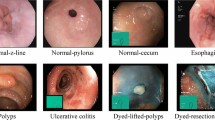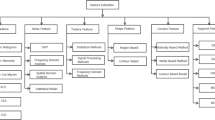Abstract
Purpose
Wireless capsule endoscopy (WCE) has become an effective facility to detect digestive tract diseases. To further improve the accuracy and efficiency of computer-aided diagnosis system in the detection of intestine polyps, a novel algorithm is proposed for WCE polyp detection in this paper.
Methods
First, by considering the rich color information of endoscopic images, a novel local color texture feature called histogram of local color difference (LCDH) is proposed for describing endoscopic images. A codebook acquisition method which is based upon positive samples is also proposed, generating more balanced visual words with the LCDH features. Furthermore, based on locality-constrained linear coding (LLC) algorithm, a normalized variance regular term is introduced as NVLLC algorithm, which considers the dispersion degree between k nearest visual words and features in the approximate coding phase. The final image representations are obtained from using the spatial matching pyramid model. Finally, the support vector machine is employed to classify the polyp images.
Results
The WCE dataset including 500 polyp and 500 normal images is adopted for evaluating the proposed method. Experimental results indicate that the classification accuracy, sensitivity and specificity have reached 96.00%, 95.80% and 96.20%, which performances better than traditional ways.
Conclusion
A novel method for WCE polyp detection is developed using LCDH feature descriptor and NVLLC coding scheme, which achieves a promising performance and can be implemented in clinical-assisted diagnosis of intestinal diseases.









Similar content being viewed by others
References
Alaskar H, Hussain A, Al-Aseem N, Liatsis P, Al-Jumeily D (2019) Application of convolutional neural networks for automated ulcer detection in wireless capsule endoscopy images. Sensors 19(6):1265
Bernal J, Tajkbaksh N, Sánchez FJ, Matuszewski BJ, Chen H, Yu L, Angermann Q, Romain O, Rustad B, Balasingham I (2017) Comparative validation of polyp detection methods in video colonoscopy: results from the miccai 2015 endoscopic vision challenge. IEEE Trans Med Imaging 36(6):1231–1249
Charfi S, El Ansari M (2018) Computer-aided diagnosis system for colon abnormalities detection in wireless capsule endoscopy images. Multimed Tools Appl 77(3):4047–4064
Cong Y, Wang S, Liu J, Cao J, Yang Y, Luo J (2015) Deep sparse feature selection for computer aided endoscopy diagnosis. Pattern Recognit 48(3):907–917
Csurka G, Dance C, Fan L, Willamowski J, Bray C (2004) Visual categorization with bags of keypoints. In: Workshop on statistical learning in computer vision, ECCV, Prague 1, pp 1–2
Dalal N, Triggs B (2005) Histograms of oriented gradients for human detection. In: 2005 IEEE computer society conference on computer vision and pattern recognition. IEEE, vol 1, pp 886–893
Firuzi K, Vakilian M, Darabad V, Phung B, Blackburn T (2017) A novel method for differentiating and clustering multiple partial discharge sources using s transform and bag of words feature. IEEE Trans Dielectr Electr Insul 24(6):3694–3702
Iakovidis DK, Koulaouzidis A (2015) Software for enhanced video capsule endoscopy: challenges for essential progress. Nat Rev Gastroenterol Hepatol 12(3):172
Lazebnik S, Schmid C, Ponce J (2006) Beyond bags of features: spatial pyramid matching for recognizing natural scene categories. In: 2006 IEEE computer society conference on computer vision and pattern recognition (CVPR’06). IEEE, vol 2, pp 2169–2178
Leenhardt R, Vasseur P, Li C, Saurin JC, Rahmi G, Cholet F, Becq A, Marteau P, Histace A, Dray X (2019) A neural network algorithm for detection of gi angiectasia during small-bowel capsule endoscopy. Gastrointest Endosc 89(1):189–194
Leufkens A, Van Oijen M, Vleggaar F, Siersema P (2012) Factors influencing the miss rate of polyps in a back-to-back colonoscopy study. Endoscopy 44(05):470–475
Lim EG, Wang Z, Nie S, Tillo T, Man KL, Zhang N (2014) Moveable wireless capsule endoscopy. In: Soc design conference
Lindeberg T (2012) Scale invariant feature transform. Scholarpedia 7(5):2012–2021
Liu PN, Liu GJ, Guo MZ, Liu Y, Pan LI (2015) Image classification based on non-negative locality-constrained linear coding. Acta Autom Sin 41(7):1235–1243
López-Monroy AP, Montes-y Gómez M, Escalante HJ, González FA (2019) Novel distributional visual-feature representations for image classification. Multimed Tools Appl 78(9):11313–11336
Nazir S, Yousaf MH, Velastin SA (2018) Evaluating a bag-of-visual features approach using spatio-temporal features for action recognition. Comput Electr Eng 72:660–669
Neumann H, Hassan C (2017) Small and diminutive polyps: no cancer, no risk!. Dig Liver Dis 49(1):1–2
Pitchumoni C, Gidwaney NG (2012) Wireless capsule endoscopy. In: Pitchumoni CS, Dharmarajan TS (eds) Geriatric gastroenterology. Springer, New York, pp 221–226
Pogorelov K, Randel KR, Griwodz C, Eskeland SL, de Lange T, Johansen D, Spampinato C, Dang-Nguyen DT, Lux M, Schmidt PT (2017) Kvasir: A multi-class image dataset for computer aided gastrointestinal disease detection. In: Proceedings of the 8th ACM on multimedia systems conference, pp 164–169
Pogorelov K, Ostroukhova O, Jeppsson M, Espeland H, Griwodz C, de Lange T, Johansen D, Riegler M, Halvorsen P (2018) Deep learning and hand-crafted feature based approaches for polyp detection in medical videos. In: 2018 IEEE 31st international symposium on computer-based medical systems (CBMS). IEEE, pp 381–386
Sanchez-Gonzalez A, Garcia-Zapirain B, Sierra-Sosa D, Elmaghraby A (2018) Automatized colon polyp segmentation via contour region analysis. Comput Biol Med 100:152–164
Shanmuga Sundaram P, Santhiyakumari N (2019) An enhancement of computer aided approach for colon cancer detection in wce images using roi based color histogram and svm2. J Med Syst 43(2):29
Shin Y, Balasingham I (2017) Comparison of hand-craft feature based svm and cnn based deep learning framework for automatic polyp classification. In: 2017 39th annual international conference of the ieee engineering in medicine and biology society (EMBC). IEEE, pp 3277–3280
Shin Y, Qadir HA, Aabakken L, Bergsland J, Balasingham I (2018) Automatic colon polyp detection using region based deep cnn and post learning approaches. IEEE Access 6:40950–40962
Siddiqui AJ, Mammeri A, Boukerche A (2016) Real-time vehicle make and model recognition based on a bag of surf features. IEEE Trans Intell Transp Syst 17(11):3205–3219
Siegel RL, Miller KD, Jemal A (2019) Cancer statistics. CA Cancer J Clin 69(1):7–34
Silva J, Histace A, Romain O, Dray X, Granado B (2014) Toward embedded detection of polyps in wce images for early diagnosis of colorectal cancer. Int J Comput Assist Radiol Surg 9(2):283–293
Tajbakhsh N, Shin JY, Gurudu SR, Hurst RT, Kendall CB, Gotway MB, Liang J (2016) Convolutional neural networks for medical image analysis: full training or fine tuning? IEEE Trans Med Imaging 35(5):1299–1312
Wang J, Yang J, Yu K, Lv F, Huang T, Gong Y (2010) Locality-constrained linear coding for image classification. In: 2010 IEEE computer society conference on computer vision and pattern recognition, Citeseer, pp 3360–3367
Wimmer G, Tamaki T, Tischendorf JJ, Häfner M, Yoshida S, Tanaka S, Uhl A (2016) Directional wavelet based features for colonic polyp classification. Med Image Anal 31:16–36
Yang J, Yu K, Gong Y, Huang T (2009) Linear spatial pyramid matching using sparse coding for image classification. In: 2009 IEEE conference on computer vision and pattern recognition. IEEE, pp 1794–1801
Yu K, Zhang T, Gong Y (2009) Nonlinear learning using local coordinate coding. In: Bengio Y, Schuurmans D, Lafferty JD, Williams CKI, Culotta A (eds) Advances in neural information processing systems. Curran Associates, New York, pp 2223–2231
Yuan Y, Li B, Meng MQH (2016a) Wce abnormality detection based on saliency and adaptive locality-constrained linear coding. IEEE Trans Autom Sci Eng 14(1):149–159
Yuan Y, Li B, Meng QH (2016b) Improved bag of feature for automatic polyp detection in wireless capsule endoscopy images. IEEE Trans Autom Sci Eng 13(2):529–535
Zauber AG, Winawer SJ, O’Brien MJ (2012) Colonoscopic polypectomy and long-term prevention of colorectal-cancer deaths. N Engl J Med 366(8):687–696
Zhang R, Shen J, Wei F, Li X, Sangaiah AK (2017) Medical image classification based on multi-scale non-negative sparse coding. Artif Intell Med 83:44–51
Author information
Authors and Affiliations
Corresponding author
Ethics declarations
Funding
This study was funded by National Natural Science Foundation of China (Grant 61675183), Natural Science Foundation of Zhejiang Province (Grant LY18F010023), Key R & D Program Projects in Zhejiang Province (Grant 2020C03047).
Conflict of Interest
Jianjun Yang, Liping Chang, Sheng Li, Xiongxiong He and Tingwei Zhu declare that they have no conflict of interest.
Ethical Approval
This article does not contain any studies with human participants or animals performed by any of the authors.
Additional information
Publisher's Note
Springer Nature remains neutral with regard to jurisdictional claims in published maps and institutional affiliations.
Rights and permissions
About this article
Cite this article
Yang, J., Chang, L., Li, S. et al. WCE polyp detection based on novel feature descriptor with normalized variance locality-constrained linear coding. Int J CARS 15, 1291–1302 (2020). https://doi.org/10.1007/s11548-020-02190-3
Received:
Accepted:
Published:
Issue Date:
DOI: https://doi.org/10.1007/s11548-020-02190-3




